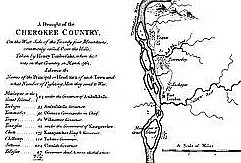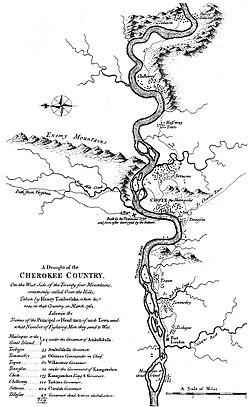Recent announcements of grant funding for the preservation of Brown's Tavern, the oldest historical structure in Hamilton County, and the Battlefield at Wauhatchie, named for a Cherokee chief who fought alongside John Ross, Major Ridge and Tennessee's Andrew Jackson at Horseshoe Bend, have sparked a renewed interest in the region's Cherokee history. It seems appropriate to recount the history of one of the Cherokee's most revered but controversial leaders, Dragging Canoe.
During the earliest days in western North Carolina, lands today included in Tennessee, there was little conflict between the European-American settlers and the Cherokee. However, that would change with the continuing encroachment on native lands and the rising sentiments noted in a Watauga document encouraging settlers to "share in the glorious cause of Liberty."
The Treaty of Sycamore Shoals, inked in 1775 after lengthy negotiations between North Carolina's Judge Richard Henderson and Cherokee leader Little Carpenter, transferred most of central Kentucky and north central Tennessee to the Transylvania Land Company and sparked a conflict between the white settlers and the Cherokee.
Dragging Canoe, son of Little Carpenter, decried his father's actions and refused to recognize the transfer of lands for 10,000 pounds of expendable British goods. The family disagreement became a challenge for leadership, and Dragging Canoe vowed that the Tennessee lands would become a "dark and bloody ground." Organizing the Chickamaugas to make his promise a reality, he launched a 16-year war beginning in July 1776, an ironic historical footnote. Almost 240 years later, Cherokee author and activist Albert Bender wrote that Dragging Canoe spoke to his people about the loss of their lands, saying the white settlers had "surrounded us, leaving only a little spot of ground to stand upon and it seems to be their intention to destroy us as a Nation."
Dragging Canoe, leader of the "fighting Chickamaugas," is often considered to be the most significant Native leader in the Southeast, eclipsing Chief John Ross. Tecumseh, the famed Shawnee leader who lived for a time with the Chickamaugas, and Sequoyah, who would choose a different path to promote his people, both hailed Dragging Canoe as an inspiring "forefather."
While it is sometimes difficult to discern between fact and myth, research in both colonial and Cherokee documents provides some information. Cherokee records indicate that, since his father lived in Tenase until the mid-1750s, Dragging Canoe was probably born there around 1740, close to the birthdate of his cousin, Nancy Ward. Oral tradition says that, as a child, he begged his father to join a war party against the Shawnees, and his father offered his permission only if the young warrior could carry his own canoe. Undeterred by the heavy weight and encouraged by cheering warriors, the boy dragged the canoe to the river's edge and began paddling toward the war party.
Whether his name story is fact or folklore, Dragging Canoe would become a constant threat to white settlers pushing westward in search of land, freedom and economic opportunity. An examination of colonial documents indicated that by mid-July 1776, Dragging Canoe had united 14 northern tribes into an alliance, deeming the Revolution as a perfect opportunity for launching war against isolated settlers on the frontier. He is credited with devising an attack plan based on joint leadership with Old Abram and the Raven, two other experienced warriors. Old Abram and his men would attack the Watauga and Nolichucky settlements while the Raven, accompanied by a strong contingency of warriors, would hit Carter's Valley. Dragging Canoe charged his troops with an attack on the Island Flats, near present-day Kingsport.
Four Cherokee Nation traders warned the settlers of the pending attack; a messenger was then sent east, asking for reinforcements. Interestingly, the traders received word of the impending attack from Nancy Ward, who then helped them escape from the villages along the Little Tennessee and Tellico Rivers (in today's Monroe County). Five companies of militia under the leadership of Capt. James Thompson, aided by Capts. John Campbell, James Shelby, William Buchanan, William Cocke and Thomas Madison, arrived and aided the settlers in defeating the wounded Dragging Canoe and his estimated 200 warriors.
Dragging Canoe, refusing to submit, retreated and established new villages along Chickamauga Creek during the winter of 1776-77. Until his death in 1792, he would continue his fight against the settlers while also working to preserve the Cherokee culture and strengthen the Chickamaugas' alliance with the Creeks and Shawnees.
Linda Moss Mines, the Chattanooga and Hamilton County historian, serves on the Tennessee Historical Commission and is Regent, Chief John Ross Chapter, NSDAR.

